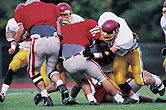- Skip Storing This Everyday Product in the Fridge Door
- Green Tea + B3 Pairing May Boost Brain Health
- Navigating Your Midlife Crisis: Embracing New Possibilities
- City Raccoons Showing Signs of Domestication
- Mapping the Exposome: Science Broadens Focus to Environmental Disease Triggers
- One Week Less on Social Media Linked to Better Mental Health
- Your Brain Changes in Stages as You Age, Study Finds
- Some Suicide Victims Show No Typical Warning Signs, Study Finds
- ByHeart Formula Faces Lawsuits After Babies Sickened With Botulism
- Switch to Vegan Diet Could Cut Your Greenhouse Gas Emissions in Half
Contact Sports Boost Spread of ‘Superbug’ Germs, Study Says


College athletes in contact sports such as football and soccer are more than twice as likely as other college athletes to carry a superbug known as methicillin-resistant Staphylococcus aureus (MRSA), new research finds.
“This study shows that even outside of a full-scale outbreak, when athletes are healthy and there are no infections, there are still a substantial number of them who are colonized with these potentially harmful bacteria,” said study co-author Natalia Jimenez-Truque, a research instructor with Vanderbilt University Medical Center in Nashville.
MRSA causes skin and soft tissue infections, which often heal on their own or are easily treated. But invasive MRSA can cause hard-to-treat infections that can be fatal. Officials estimate that MRSA kills 18,000 people in the United States each year.
In the past, MRSA was most known for causing infections in hospitals, where the patients’ immune systems may be weakened. But in recent years, it has spread into the greater community, sometimes affecting athletes who come in contact with the germs on one another’s skin on the field or in the locker room when they share towels. MRSA then “colonizes” their bodies and can develop into a serious infection if it makes its way into cuts and scrapes, experts say.
Over two years, study researchers tracked 377 male and female Vanderbilt University varsity athletes in 14 different sports. Contact sports, as opposed to sports like golf and cross-country, were played by 224 of them.
Taking monthly nasal and throat swabs, researchers found that as many as 31 percent of contact sports athletes carried MRSA compared to a high of 23 percent of the other athletes. About 5 to 10 percent of the general population have been colonized with MRSA, the researchers said.
“Sports teams can decrease the spread of MRSA by encouraging good hygiene in their athletes, including frequent hand washing and avoiding sharing towels and personal items such as soap and razors,” Jimenez-Truque said.
“Staph is a problematic germ for us — always has been, always will be — and we need to do all we can to reduce the risk of infection in those at highest risk, such as college athletes,” she said.
The study findings are scheduled for release in Philadelphia Thursday at a meeting of the Infectious Diseases Society of America, Society for Healthcare Epidemiology of America, HIV Medicine Association and Pediatric Infectious Diseases Society. The organizers call it ID Week.
Research presented at meetings is considered preliminary until published in a peer-reviewed medical journal.
More information
The U.S. Centers for Disease Control and Prevention has more about MRSA.
Source: HealthDay
Copyright © 2025 HealthDay. All rights reserved.










